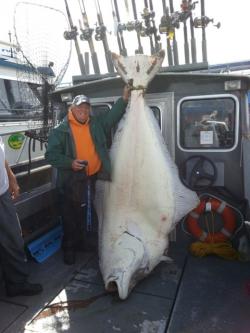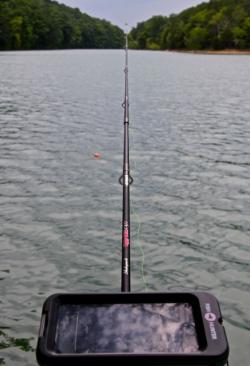480-pound halibut landed in southeast Alaska-but it’s not a world record
Editor’s Note: Occasionally, our colleagues in other publications share great stories with us. Today, we’re sharing a great one with you by Andy Martin, a field reporter for California’s Western Outdoor News. Our thanks to WON editor Bill Karr for sharing this one with our readers.
from The Fishing Wire
GUSTAVUS, ALASKA–A Southern California man caught a giant Pacific halibut in Southeast Alaska last week that rivals the sport fishing world record.
Jack McGuire of Anaheim was fishing with Capt. Rye Phillips aboard the Icy Rose on July 3 when he hooked and landed a 95-inch, 482-pound halibut near the mouth of Glacier Bay. The barndoor halibut would likely challenge the 459-pound International Game Fish Association (IGFA) world record caught in 1996 by Jack Tragis if it had not been shot and harpooned.
McGuire, 77, was fishing out of Alaskan Anglers Inn in Gustavus for the Fourth of July holiday week. Phillips took McGuire and three other passengers aboard his charter boat to one of his favorite big fish spots in Icy Straight near Lemesurier Island in about 130 feet of water.
The giant halibut hit an octopus fished just off of the bottom. It took off on a long run after the size 16/0 Eagle Claw circle hook dug in, before McGuire was able to ease it off the ocean floor, thanks mainly to the two-speed Shimano TLD II 30 two-speed reel he was using. After a 30-minute give-and-take battle, Phillips spotted the halibut below the boat and let McGuire know it was legal size. In Southeast Alaska, anglers on charter boats can keep one halibut per day as long as it is less than 44 inches, or more than 76 inches.
“It was giant,” Phillips said. “We knew right away it was over 76 inches, but we didn’t know it was going to be bigger than the world record.”
Like he does with all big halibut that anglers decide to keep, Phillips subdued the fish with a .410 shotgun, and then harpooned it. Most guides kill the giant halibut before bringing them onto their boats because of how dangerous they are if they are flopping on the deck. Some anglers have been seriously injured by trophy-size halibut.
Jack McGuire, 77, of Anaheim, California, stands next to the 95-inch, 482-pound halibut he caught July 3 near Gustavus, Alaska, while fishing with Capt. Rye Phillips of Alaskan Anglers Inn. Photo courtesy Western Outdoor News with permission.Phillips and two of the other customers used gaff hooks to pull the mammoth halibut over the side of the boat. At first the fish’s gills got stuck on the rail, but after a second attempt they were able to drag the halibut aboard.
Phillips immediately measured the fish, letting him know it was a potential world record. Unfortunately, the fish would not qualify because it was shot and harpooned. Phillips also assisted McGuire by grabbing the line and lifting on the rod during the battle.
McGuire caught the halibut on 100-pound-test Tuf Line and a 240-pound nylon leader. Phillips had rigged the rods with heavy gear because he was targeting trophy-size fish that day.
The massive halibut drew quite a crowd at the Gustavus dock. Dozens of people gathered to see the fish hoisted up for photographs before Phillips filleted it for McGuire. The halibut yielded nearly 200 pounds of boneless, skinless fillets.
Just a week earlier, Phillips, who played baseball at Western Oregon University and lives in Brookings, Ore., during the winter, put a customer into a 275-pound halibut.
Gustavus, located 45 miles west of Juneau, is a relatively unknown halibut hot spot. It typically has the largest average size of halibut caught in Alaska, according to Alaska Department of Fish and Game stats, and the small charter fleet fishing out of the Gustavus dock brings in dozens of 200-plus-pound fish each season.
Steve Brown, owner of Alaskan Anglers Inn, said each week many customers catch halibut topping 100 pounds. Last year, when anglers could keep halibut 68 inches or bigger, which weigh roughly 165 pounds or more, anglers fishing at his lodge landed more than 50 of the trophy-size fish. More than two dozen of those were over 200 pounds, including five over 300 pounds.
— Andy Martin
Martin is a Field Reporter for Western Outdoor (www.wonews.com)





